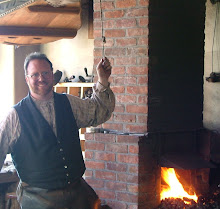Our blacksmith shop is 183 years old. Several more of our buildings are more than 200 years old. At the shop we have had to become skilled at fixing things that are worn out, broken down, rotten, or busted! Hinge pins wear down, latches get bent, tools break, and even floorboards wear through. A small but important part of our trade is to make the hardware, fasteners and tools needed to get our museum in fine fettle.
The most humble yet unavoidable need is for nails. We make a number of kinds of forged nails. Rose headed nails, common nails, two-penny nails, ten-penny spikes, and door nails perfect for clinching. Last year we used around 2,000 hand-forged nails. Once, when doing a major repair, our shop needed to make that many in two days!
When the farmers repaired the 1830’s plow, the wooden plow beam was worn, rotten, and missing hardware. Our replacement utilized the dimensions of the original and the rust stains indicating missing hardware.
Old hardware and tools often have corroded, bent, and broken bolts. Making new bolts, nuts, and washers is part of the restoration process. We replace fasteners with new ones made using the same methods and tools as the original part.
The Farmers’ Museum has a dozen buildings that are nearing two centuries of daily use. Our craftspeople and farmers are working daily using traditional tools. For the blacksmith shop it is not a question of whether things will get broken and need repair, but rather a question of what will need fixing today!











